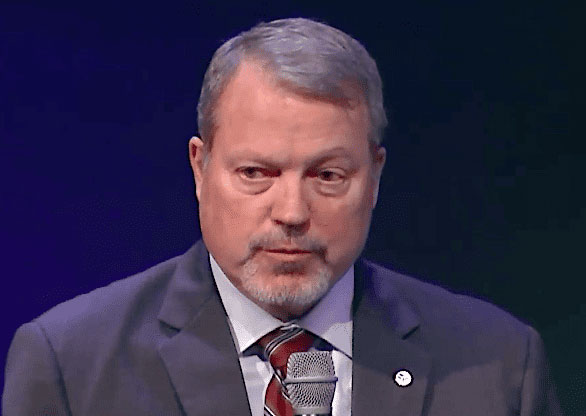 Sven Rettig, Tesat. (Source: SmallSat Symposium Silicon Valley)
Sven Rettig, Tesat. (Source: SmallSat Symposium Silicon Valley)
LA PLATA, Maryland — At least three laser-optical satellite communications systems already in orbit — two testing inter-satellite links and one for satellite-to-ground communications — are expected to deliver early results in the coming weeks.
As is often the case when the subject is satellite optical links, the U.S. Space Development Agency (SDA) is at center stage here. Twenty-three SDA satellites launched in April and June 2023, each with two optical communications terminals (OCTs) built by Tesat Spacecom, were scheduled to undergo testing as early as January.
Whether the SDA will elect to publish the early results is uncertain. The agency has made OCTs a key technology development focus for its multiple constellations of low-orbiting satellites. Tesat’s OCTs are first into orbit, but terminal builders Mynaric, Skyloom and CACI International have also been selected.
On the commercial side, Canada’s Kepler Communications has two pathfinder satellites with Tesat OCTs already in orbit for Kepler’s low-orbit constellation.
 Robert Conrade, Kepler Communicaions. (Source: SmallSat Symposium Silicon Valley)
Robert Conrade, Kepler Communicaions. (Source: SmallSat Symposium Silicon Valley)
“Commissioning of the satellites is going very well,” Robert Conrad, vice president of business development at Kepler Communications’s U.S. subsidiary, said Feb. 6 at the SmallSat Symposium in Silicon Valley, organized by SatNews Publishers.
The third experiment is a small OCT on board a satellite launched late last year for UnseenLabs, a French startup whose business is detecting radio frequencies, particularly on maritime vessels seeking to hide their whereabouts.
An UnseenLabs cubesat is carrying the Keraunos OCT, financed by France’s Definvest fund of the French Defense Ministry and Bpifrance, which is managing much of the government’s NewSpace investment. Keraunos received financing from Definvest of 5.5 million euros ($5.9 million).
Keraunos is designed to provide a high-speed optical link to a small ground station developed by Cailabs, which is developing a technology that mitigates atmospheric disturbance of the laser link.
 Jeff Huggins, Cailabs USA. (Source: SmallSat Symposium Silicon Valley)
Jeff Huggins, Cailabs USA. (Source: SmallSat Symposium Silicon Valley)
“Keraunos is up there in the sky and will be connected to use in the next few weeks,” Cailabs USA Inc. President Jeff Huggins told the conference. He said Cailabs has sold five other optical ground stations. Construction has started on two, with three others just recently contracted.
Waiting in the wings are several multibillion-dollar satellite constellations that plan to adopt OCTs but want to be sure of their reliability. They are counting on the SDA to prove out the technology for inter-satellite communications but are facing near-term development deadlines that may force them to decide before the SDA results are known. These constellations, including Telesat Lightspeed, Rivada Space Networks and the European Union’s Iris2 secure-communications constellation, will need several thousand OCTs.
Kepler is looking to use the results from SDA’s compatibility standard, which assures that all SDA OCT providers’ hardware can function in space with all the others. Kepler’s Conrad referred to “the significant investment SDA has put into… the standards. We have adopted the SDA standard and that’s going to be flying on our satellites.”
Tesat has 46 OCTs on the 23 SDA satellites launched in 2023, in addition to the two on the Kepler pathfinders. The company has recently invested in a new OCT manufacturing plant in Germany, capable of producing 20 OCTs a week on a single shift.
“The constellation market is asking for 100s or 1000s of terminals in a short time,” Retting said. “You have to ramp your manufacturing, and the value and supply chain, to be ready.”
The big market short-term is inter-satellite applications, but Rettig said space-to-ground should be a clear value once constellations have enough OCT-equipped satellites in orbit so that multiple ground stations make good business sense.
He said the SDA and Kepler networks alone might justify distributing ground stations in cloud-free regions so that data can be sped from satellite to satellite and then to the ground, all through optical channels. Tesat is also testing a space-to-ground application.
Mynaric is in a similar position. While its OCTs have not yet launched, it is an SDA provider and already has a backlog of 800 OCTs. The company has invested in a production line capable of producing 80 OCTs per month.
 Tim Deaver, Mynaric. (Source: SmallSat Symposium Silicon Valley)
Tim Deaver, Mynaric. (Source: SmallSat Symposium Silicon Valley)
“We have several commercial customers out there,” said Tim Deaver, Mynaric vice president for U.S. government and strategic solutions. “Kepler would be one. Others are coming out and RFPs are in BAFO [best and final offer] phases.”
Deaver said Mynaric has passed its SDA interoperability tests, conducted by the U.S. Naval Research Lab. “It’s amazing that the toughest points I’ve seen are not on the optical side but on the digital electronics side,” he said.
Mynaric and Tesat, both based in Germany, have set up proxy companies in the United States to deal with U.S. government work. Germany is one of multiple U.S. allies to have signed defense cooperation agreements with the U.S. government, enabling it to do SDA work.
“If you have that agreement with the U.S., you are considered a domestic provider for defense programs,” Deaver said. “Unfortunately that does not cross over into NASA, which has its own regulations for 50% U.S. content, so you split production between the U.S. and international.”
Mynaric and Tesat will be prime candidates for the European Iris2 constellation, for which a prime contract with an industrial concessionaire — Iris2 is a public-private partnership — is expected to be signed by the end of March.
Rettig said one issue with the SDA’s standard — the most recent, SDA 3.1, dates from March 2023 — is that it is limited to 2.5 Gbps.
“Maybe they don’t need more,” Rettig said of the SDA network. “But this is just not enough. Every commercial customer has asking for SDA standards, but they are talking about 10 or 100 Gbps.”
